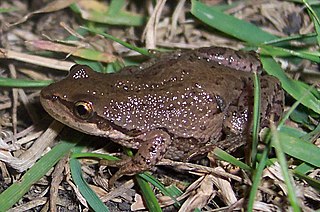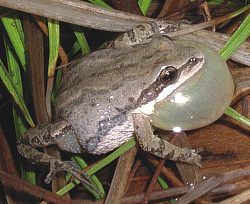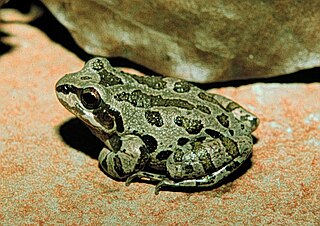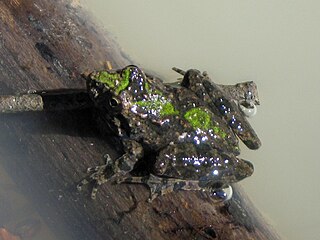
The ornate chorus frog is a species of chorus frog endemic to the Southeastern United States. Their distribution ranges from North Carolina, east to the very eastern part of Louisiana, and south to northern parts of Florida.

The spring peeper is a small chorus frog widespread throughout the eastern United States and Canada. It prefers permanent ponds due to its advantage in avoiding predation; however, it is very adaptable with respect to the habitat it can live in. In northern regions, the frog is able to endure below freezing temperatures due to the capacity of its liver to exude and flush the bloodstream with a glucose cryoprotectant which acts both as an anti-freeze in its blood, and allows organs like the heart to enter into a state of protected dormancy. The peeper earned its name from its chirping call, which marks the beginning of spring. Crucifer is derived from the Latin root meaning "cross-bearing", a reference to the cross-like pattern on the spring peeper's dorsal side.

Spea hammondii, also known as the western spadefoot, western spadefoot toad, Hammond's spadefoot, or Hammond's spadefoot toad, is a species of amphibian in the family Scaphiopodidae. It is found in western California (USA) and northwestern Baja California (Mexico). The specific name hammondii is in honor of physician and naturalist William Alexander Hammond.

The Pacific tree frog, also known as the Pacific chorus frog, has a range spanning the Pacific Northwest, from Northern California, Oregon, and Washington to British Columbia in Canada and extreme southern Alaska. They live from sea level to more than 10,000 feet in many types of habitats, reproducing in aquatic settings. They occur in shades of greens or browns and can change colors over periods of hours and weeks.

The boreal chorus frog is a species of chorus frog native to Canada from central Quebec to eastern British Columbia and north to the Northwest Territories and the southern portion of the Yukon. It occurs in the USA throughout Montana, northwestern Wisconsin, northeastern Arizona, northern New Mexico, and southwestern Utah.

The spotted chorus frog or Clark's tree frog is a small, nocturnal chorus frog native to the grasslands and prairies of the central United States and Tamaulipas, Mexico.

The western chorus frog, also known as striped chorus frog, or midland chorus frog is a species of frog found in Canada and the United States.

The upland chorus frog is a species of chorus frog found in the United States. It was recently separated from the Western chorus frog, being identified as an individual species rather than a subspecies. They are a rarely seen species, but their calls are frequently heard soon after rains in the spring time.

The little grass frog is a species of chorus frog endemic to the Southeastern United States. It is currently the smallest North American anuran and occurs in a wide variety of ephemeral and semi-permanent wetlands.

The oak toad is a species of toad in the family Bufonidae. It is endemic to the coastal regions of southeastern United States. It is regarded as the smallest species of toad in North America, with a length of 19 to 33 mm.

Dendropsophus phlebodes, the San Carlos treefrog or San Carlos dwarf treefrog, is a species of frog in the family Hylidae. It is found in western Colombia, Costa Rica, Nicaragua and Panama. Its natural habitats are tropical moist lowland forests, but it may also occur in disturbed habitats. It is threatened by habitat loss.

The Appalachianmountain chorus frog, formerly known as just the mountain chorus frog, is a species of frog in the family Hylidae. The species is endemic to the United States. The natural habitats of P. brachyphona are temperate forests, rivers, intermittent rivers, swamps, freshwater marshes, intermittent freshwater marshes, freshwater springs, ponds, open excavations, and canals and ditches. It is threatened by habitat loss.

Brimley's chorus frog is a species of frog in the family Hylidae. It is endemic to the United States and is named for North Carolina zoologist C.S. Brimley.
Ptychadena uzungwensis is a species of frog in the family Ptychadenidae. It is found on the East African Plateau in Rwanda, Burundi, and Tanzania in the north and then southward to eastern Democratic Republic of the Congo, northern Angola, Zambia, Malawi, Zimbabwe and uplands of Mozambique. Its common names include Udzungwa ridged frog and Udzungwa grass frog, where "Udzungwa" may also be written Uzungwa, following the spelling that Arthur Loveridge used in the species description for the Udzungwa Mountains, the type locality.

The banded stream frog, also known as the banded sand frog, Cape grass frog, Cape stream frog, long-toed frog, mountain frog or Jonkersberg frog, is a species of frogs in the family Pyxicephalidae. It is endemic to South Africa.

Pseudacris fouquettei is a species of chorus frog found in the south-eastern United States. It was recently separated from similar species, Pseudacris feriarum.

The Illinois chorus frog is a species of chorus frog that lives in scattered, restricted habitat ecosystems in the states of Arkansas, Illinois, and Missouri. It was published by Smith in 1951. Its life cycle is little known, its isolated populations are increasingly restricted by agricultural drainage, and it is listed as a threatened subspecies. It is often referred to as a subspecies of P. streckeri. Collins recognized it as its own species which was followed by ASW6.0 and Amphibiaweb on the basis of its diagnosability from Pseudacris streckeri and its allopatry. The IUCNredlist 2013.2 has not incorporated this taxonomic split.

Acrisinae is a subfamily of the tree frog family Hylidae. There are only two genera in this subfamily, Acris and Pseudacris. They are native to most of the Nearctic realm, and are found as far north as the Great Slave Lake in Canada, all across the United States, and down Baja California and some parts of northern Mexico. One species, the pacific tree frog, has been introduced to several locations outside its range, and it is possible that other species may have been as well.

















